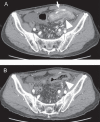Colonic stenosis caused by infection of an intraperitoneal access port system: a rare complication of intraperitoneal chemotherapy for gastric cancer with peritoneal metastasis
- PMID: 24893606
- PMCID: PMC4050104
- DOI: 10.1186/1477-7819-12-177
Colonic stenosis caused by infection of an intraperitoneal access port system: a rare complication of intraperitoneal chemotherapy for gastric cancer with peritoneal metastasis
Abstract
Background: Intraperitoneal (i.p.) chemotherapy is garnering attention as an effective treatment for gastric cancer with peritoneal metastasis. We report the case of a patient who developed colonic stenosis caused by infection of an i.p. access port system during i.p. chemotherapy. It was difficult to differentiate whether the extrinsic colonic stenosis arose from a catheter infection or peritoneal metastasis of the gastric cancer.
Case presentation: A 66-year-old Japanese man underwent total gastrectomy for gastric cancer. Because the intraoperative findings revealed peritoneal metastasis, a port system was implanted for subsequent i.p. chemotherapy. Two months after initiation of chemotherapy, he complained of vomiting and abdominal pain. A computed tomography scan revealed marked thickening of the sigmoid colon wall adjacent to the catheter of the i.p. access port system. A barium enema demonstrated extrinsic irregular stenosis of the sigmoid colon. Although it was difficult to distinguish whether infection or peritoneal metastasis had caused the colonic stenosis, we removed the port system to obtain a therapeutic diagnosis. Coagulase-negative staphylococci were detected by catheter culture. The wall thickening and stenosis of the sigmoid colon completely resolved after removal of the port system.
Conclusions: We report the case of a rare complication in association with an i.p. access port system. Infection of the port system should be considered as a differential diagnosis when colonic stenosis adjacent to the catheter is observed during i.p. chemotherapy.
Figures



Similar articles
-
Complications and management of an implanted intraperitoneal access port system for intraperitoneal chemotherapy for gastric cancer with peritoneal metastasis.Jpn J Clin Oncol. 2012 Nov;42(11):1013-9. doi: 10.1093/jjco/hys129. Epub 2012 Aug 7. Jpn J Clin Oncol. 2012. PMID: 22872745
-
[Laparoscopic peritoneal dialysis catheter implantation in peritoneal chemotherapy for gastric cancer with peritoneal metastasis].Zhonghua Wei Chang Wai Ke Za Zhi. 2019 Aug 25;22(8):774-780. doi: 10.3760/cma.j.issn.1671-0274.2019.08.013. Zhonghua Wei Chang Wai Ke Za Zhi. 2019. PMID: 31422617 Chinese.
-
[Laparoscopic diagnosis of postoperative recurrence of peritoneal metastasis in gastric cancer patients and the clinical efficacy of bidirectional intraperitoneal and systemic chemotherapy].Zhonghua Wei Chang Wai Ke Za Zhi. 2020 May 25;23(5):492-498. doi: 10.3760/cma.j.cn.441530-20200415-00210. Zhonghua Wei Chang Wai Ke Za Zhi. 2020. PMID: 32842430 Chinese.
-
[Normothermic intraperitoneal and systemic treatment (NIPS) for gastric cancer with peritoneal metastasis: Japanese experience].Zhonghua Wei Chang Wai Ke Za Zhi. 2025 May 25;28(5):487-492. doi: 10.3760/cma.j.cn441530-20250319-00109. Zhonghua Wei Chang Wai Ke Za Zhi. 2025. PMID: 40404366 Review. Chinese.
-
Intraperitoneal chemotherapy for gastric cancer with peritoneal metastasis.Gastric Cancer. 2017 Mar;20(Suppl 1):111-121. doi: 10.1007/s10120-016-0662-9. Epub 2016 Nov 1. Gastric Cancer. 2017. PMID: 27803990 Review.
References
-
- Francis P, Rowinsky E, Schneider J, Hakes T, Hoskins W, Markman M. Phase I feasibility and pharmacologic study of weekly intraperitoneal paclitaxel: a gynecologic oncology group pilot study. J Clin Oncol. 1995;13:2961–2967. - PubMed
-
- Markman M, Brady MF, Spirtos NM, Hanjani P, Rubin SC. Gynecologic Oncology Group. Phase II trial of intraperitoneal paclitaxel in carcinoma of the ovary, tube, and peritoneum. J Clin Oncol. 1998;16:2620–2624. - PubMed
Publication types
MeSH terms
LinkOut - more resources
Full Text Sources
Other Literature Sources
Medical

